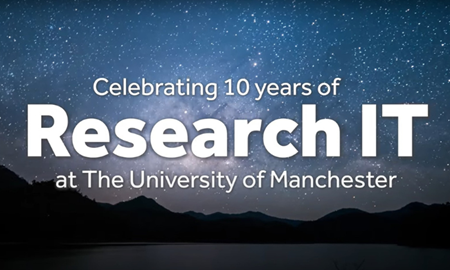In the Beginning
During a presentation to the University’s IT community, Rob Haines, Director of Research IT provided a timeline of key events in IT for research. He looked back with a hint of nostalgia to when the University hosted the UK’s National Supercomputing Service - Computational Services for Academic Research (CSAR). In 1998, CSAR hosted the 7th fastest computer in the world, and continued providing service until 2006.
Meanwhile, other groups which supported research included the Manchester Visualisation Centre, MIMAS and the e-Science team. These were largely funded externally and perhaps didn’t focus enough on services for University of Manchester researchers.
The Birth of Research IT
The desire to invest in centralised, permanent, dedicated IT services for research at the University began to grow from 2011. Nationally, the Software Sustainability Institute was well established, and at their Collaborations Workshop in early 2012, the role of Research Software Engineer was invented. Locally, the Computational Shared Facility was inaugurated as a high-performance computing environment, and in 2013, an internal report was commissioned to determine the necessary IT services to support research. The following year, Professor Douglas Kell's report recommended establishing a central pool of approximately 50 Research IT roles. Between 2014 and 2015, a prototype team was formed, leading to the official launch of Research IT in 2015.
A Decade of Progress
In 2015, the team was made up of fewer than 20 people. Fast forward to today, and the team has grown to over 100, offering a wide range of off-the-shelf and bespoke facilities and services tailored to the specialised needs of the research community. These include high-performance computing, software engineering, collaboration, training, outreach, the Research Lifecycle Programme, secure storage, and advanced data manipulation. With deep IT expertise, the team takes a collaborative approach to delivering innovative solutions for research projects, team members are often cited as collaborators on research outputs.
Did you know?
As of 2025, the Computational Shared Facility (CSF) comprises three systems, supporting 1,600 users across 46 research groups. It features 32,000 CPUs and 152 GPUs. Hosting, powering, and supporting the CSF costs over £2 million annually. Over the past five years, more than £6 million has been invested by research projects and the Research Lifecycle Programme to improve the CSF. The return on investment is substantial, as the CSF supports externally funded research projects valued at more than £99 million.
Research Software Engineering (RSE) started with around 5 engineers and has expanded to 50 over the past decade. Currently, there are 70 active projects, and it is estimated that 420 research projects of varying complexity and scale have been serviced during this period. Between them the RSE team boasts over 400 unique skills and areas of expertise.
Present and Future
As the demand for dedicated, centralised Research IT services at the University continues to grow, Research IT remains committed to listening to and adapting to the needs of the research community. Our mission is to continue to support research projects of all sizes throughout their lifecycle. Providing proven platforms for common needs and bespoke solutions for unique challenges. We share our expertise so researchers can concentrate on their research.
Celebrating a Decade
To commemorate this significant milestone, we have created a special video featuring colleagues from Research IT and the wider University, reflecting on the past ten years and looking ahead to the future.
Rob concludes with a heartfelt thank you to all staff and customers, past and present, and expresses his optimism for the future.
"Thank you for being a part of our remarkable journey. Here’s to many more years of empowering world-class research!"

